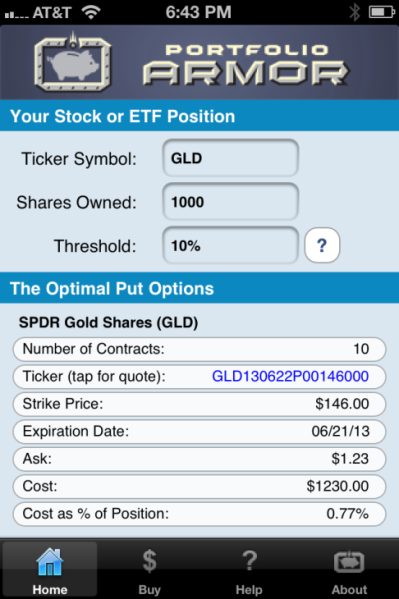Gold Bugs Crushed
Hey fellow Slopers,
As Tim noted on Friday (“Kooks’ Last Stand”), the collapse in gold and its SPDR tracking ETF GLD has been shocking, particularly to those who figured QE Infinity would drive gold prices to new highs. Back in January, I posted a couple of GLD hedges. In this post, we’ll take a look at how one of them reacted as GLD dropped on Friday. Then we’ll look at a way to hedge GLD now.
How You Could Have Hedged Your GLD Shares
In late January, we posted two inexpensive ways to hedge 1000 shares of the SPDR Gold Trust ETF (GLD) against a greater-than-10% drop over the next several months. This was one of them:

As you can see at the bottom of the screen capture above, the cost of this put protection, as a percentage of position value, was quite inexpensive: only 0.77%. Note that, to be conservative, the cost here was calculated using the ask price of the optimal puts. In practice, an investor can often buy puts for a lower price, i.e., some price between the bid and ask.
How GLD Has Performed Since We Posted That Hedge
Not well. GLD has declined 10.4% since, as of Friday’s close, as the chart below shows.
How Those Optimal Puts Reacted To GLD’s Drop
The screen capture below shows how those optimal puts we showed back in January reacted to GLD’s drop on Friday, April 12th.
As you can see in the screen capture above, those puts jumped more than 206%, on a day when GLD dropped 4.7%. This is an example of the nonlinearity of options, which enables a small dollar amount of put options can protect a much larger position in an underlying security, such as GLD.
How That Hedge Cushioned GLD’s Drop
GLD closed at $160.65 on January 27th. An investor who owned 1000 shares and bought the optimal puts to hedge it against a >10% drop that day had $160,650 in GLD and an outlay of $1,230 on the puts (again, assuming, conservatively, that he bought the puts at the ask). $160,650 + $1,230 = $161,880.
On Friday, April 12th, GLD closed at $143.95, and those puts closed at $5.70. As of Friday’s close, our investor’s GLD shares were worth $143,950 and his put options were worth $5,700: $143,950 + $5,700 = $149,650.
So, although GLD dropped about 10.4% from January 25th’s close to April 12th’s close, an investor who bought those puts on January 25th was only down about 7.6% on his combined hedge + underlying stock position over the same time frame.
More Protection Than Promised
Recall that the optimal put hedge was designed to protect against a greater-than-10% decline. Because these had plenty of time value in addition to intrinsic value as of April 12th’s close, they offered more protection than that.
Hedging GLD Now
The screen capture below shows the optimal puts, as of Friday’s close, to hedge 1000 shares of GLD against another, greater-than-10% drop by September 20th.

As you can see at the bottom of the screen capture above, the cost of this protection, as a percentage of position value, was 1.91% — nearly 2.5x as expensive as it was to hedge against the same percentage drop back in January. It’s still cheap to hedge against a larger drop, though. As of Friday’s close, the cost of hedging GLD against a greater-than-20% drop over the same time frame was about 0.50%. Though it’s no longer cheaper to hedge GLD than SPY, as it had been for most of this year: the cost of hedging SPY against a greater-than-20% drop was 0.45% as of Friday.
*Optimal puts are the ones that will give you the level of protection you want at the lowest possible cost. Portfolio Armor uses an algorithm developed by a postdoctoral fellow at Princeton University’s financial engineering department to sort through and analyze all of the available puts for your stocks and ETFs, scanning for the optimal ones. The screen capture above is from the Portfolio Armor iOS App.

